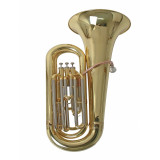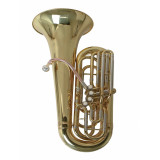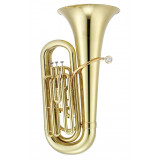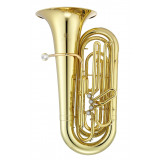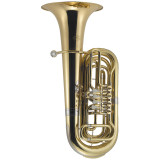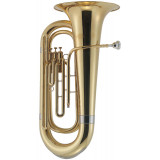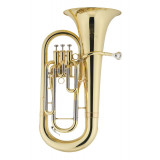Tubas / Euphoniums
A tuba is a brass instrument characterized by its large size and deep sound. It consists of vertically coiled tubing, three, four or five valves, a wide conical bore, flared bell, and a cup-shaped mouthpiece. Since the tuba was first introduced, the world's greatest composers have included it in their music. By far the biggest instrument in the brass family, it also just happens to produce the lowest pitch, and today it can be found in symphony orchestras, military bands and even jazz ensembles. In 1835, the first tuba was patented by Johann Gottfried Moritz and Wilhelm Wiprecht. The overall design of the tube has changed little since the early days of its development.
Sizes
A tuba is a massive instrument with a large bell from 14 to 30 inches in diameter. The size of the bell has an effect on the sound produced and projected. Although there are a variety of different tuba types available on the market, Bb and C are the most common choices. Since Bb tubas have a broader sound with extra weight, they help bring balance to a band’s sound and are the preferred choice for most school marching bands. C tubas, on the other hand, have a clearer and more compact sound, making them the perfect choice for orchestras.
Valves
The more valves a tube has, the greater its range will be. Most tubes have four piston valves. Valves can be either piston or rotary. Piston valves require more maintenance than rotary valves, but are very simple to disassemble and re-assemble for oiling. Piston valves can be oriented to point to the top of the instrument (top-action), or out the front of the instrument (front-action or side-action). Piston valves come standard on most student tubas, while most intermediate and professional models are manufactured with rotary valves.
Materials
The primary raw material used for making standard tubas is brass. Brass is an alloy composed of copper and zinc. Other metals that may also be added to modify the characteristics include tin and nickel. In addition to brass, other materials are used to make tubas. Most of the screws are composed of stainless steel. In some cases, certain surfaces on the instrument such as the valves or the sliding pipes are coated with chromium or a nickel alloy. This reduces friction and helps the pieces move more freely. Tubas manufactured from gold brass have a darker sound than yellow brass tubas, while those manufactured from rose brass have a very warm tone that can’t be reproduced by either of the other options.
The demand for tubas is much less than for other brass instruments such as trumpets or trombones. Consequently, production is usually not automated. As with any major purchase, the cost of a tube depends a lot on who makes it. Before buying, you need to think about your budget and skill level - the tube that suits you will be found in no time.
Buy Tubas / Euphoniums in Musician.UA
In the “Musician” stores you can buy a tuba / euphonium and all the necessary accessories, such as a tuba stand, valve oil, polish, mouthpiece brush, polishing cloth, music stand and much more. To do this, place an order on our website musician.ua. You have the opportunity to order a delivery. You can always count on professional advice and assistance in choosing the right product. We care about the quality of service and do our best to make you happy with your purchase.

 ARTURIA Instruments
ARTURIA Instruments
 Drums for Therapy
Drums for Therapy  Harps
Harps
 Lyres
Lyres
 Didgeridoo
Didgeridoo
 Sound Processing
Sound Processing
 Mixing Consoles
Mixing Consoles
 Vinyl Players
Vinyl Players
 Phono Correctors
Phono Correctors
 Karaoke
Karaoke
 Stands and Holders
Stands and Holders
 Trolleys
Trolleys
 Computers, Electronics
Computers, Electronics
